Create
Messaging
This document provides design and experience guidelines for embedded apps running in a Messaging space, specifically:
- Requirements that in-space embedded apps must meet to be approved for inclusion on Webex App Hub.
- Recommended design guidelines that when implemented provide a great experience for users of in-space apps. While not explicitly required, apps that do not incorporate the recommended guidelines may not be approved if it is determined they provide a poor user experience.
- Good-to-have design guidelines that when incorporated into embedded apps provide an enhanced user experience, both within the app itself and the larger Webex context.
Webex App Hub is not supported for Webex for Government (FedRAMP).
See Embedded Apps Design and Experience Guidelines for Meetings related to meeting-based apps.
anchorRequirements for In-Space Embedded Apps
anchorThis section describes design and user experience requirements for in-space embedded apps.
- Add Tab to Space Experience
- Responsive Layout
- Platform and Device Support
- Use of Pop-up Windows
- Access to User Information
- First-time User Experience
- Legibility in Light and Dark Modes
- Other
Add Tab to Space Experience
In a messaging space, the app initiator selects or specifies the content to share, and then clicks Add to Tab to add the specified content as a space tab. For a detailed overview of the in-space experience, see In-Space App Experience in the Embedded Apps documentation.
The following requirements are to ensure that an app's Add to Tab workflows are clear and intuitive to users.
- Apps must have at least one workflow that results in Add to Tab appearing.
- Once an app is added as a tab, all members of the space must see the same content that was intended to be shared.
- If users are required to sign-in or sign-up before using the app, the app must present the user's initial view or context when they complete the sign-in or sign-up process.
- The shared app's main content and features must be presented in the space tab, not in external pop-up windows (see Use of Pop-up Windows). Pop-up windows must be used only for specific actions, such as sign-in or sign-up workflows, and must be closed after the action is complete.
- Apps added to a tab must provide a consistent experience each time a user opens the app. Apps should use local storage to maintain state between sessions.
Responsive Layout
In-space apps must optimize their layouts to the default window sizes in which they run. By default, the app used to add a space tab opens in a 580x597px window. The app's layout must be optimized for this viewport.
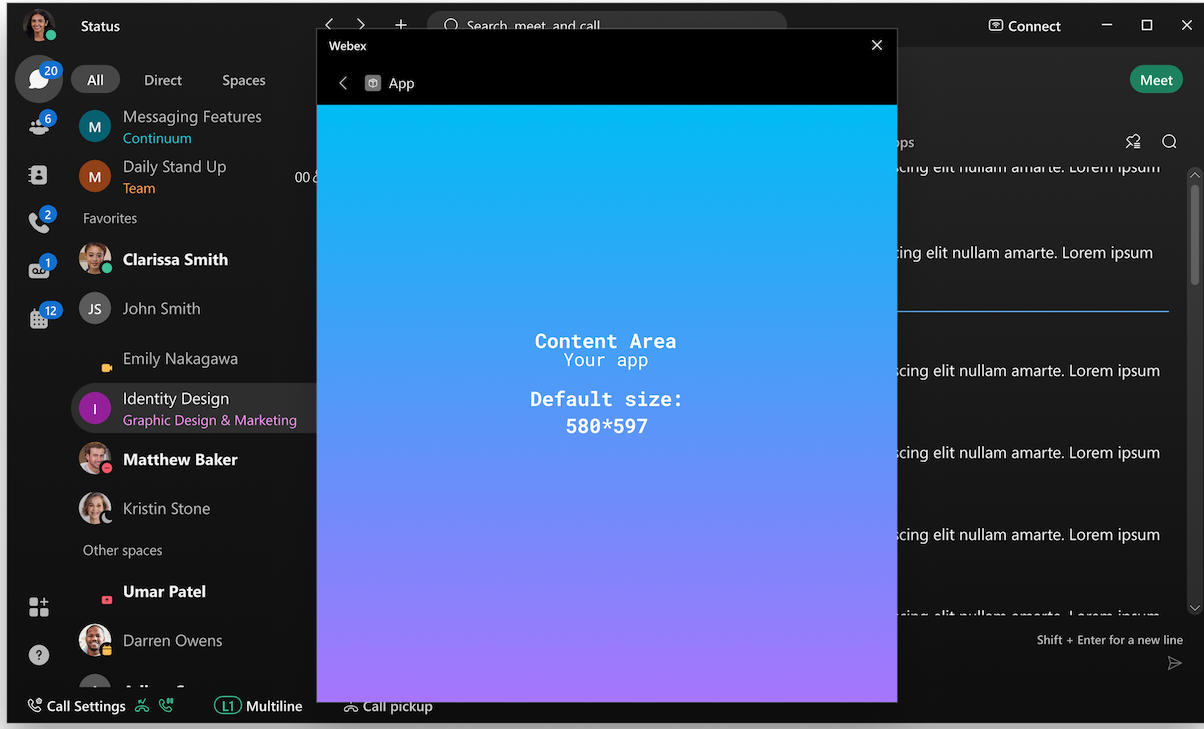
When the Add to Tab button is enabled, the available screen area is 580x525px. The app's layout must be optimized for this view.
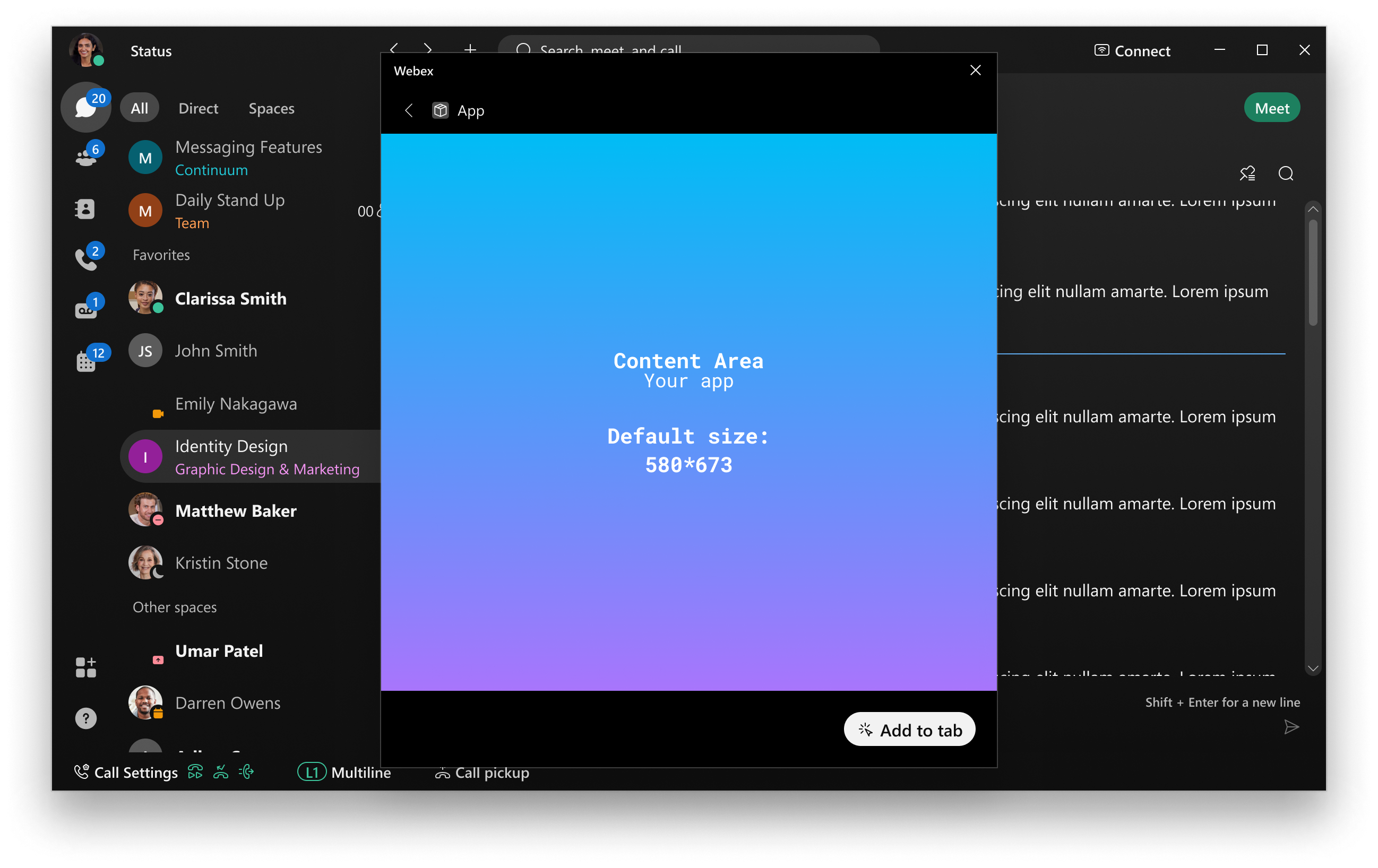
The default dimensions of an app that has been added to a space is 780x520px. App layouts must be optimized for this initial viewport size.
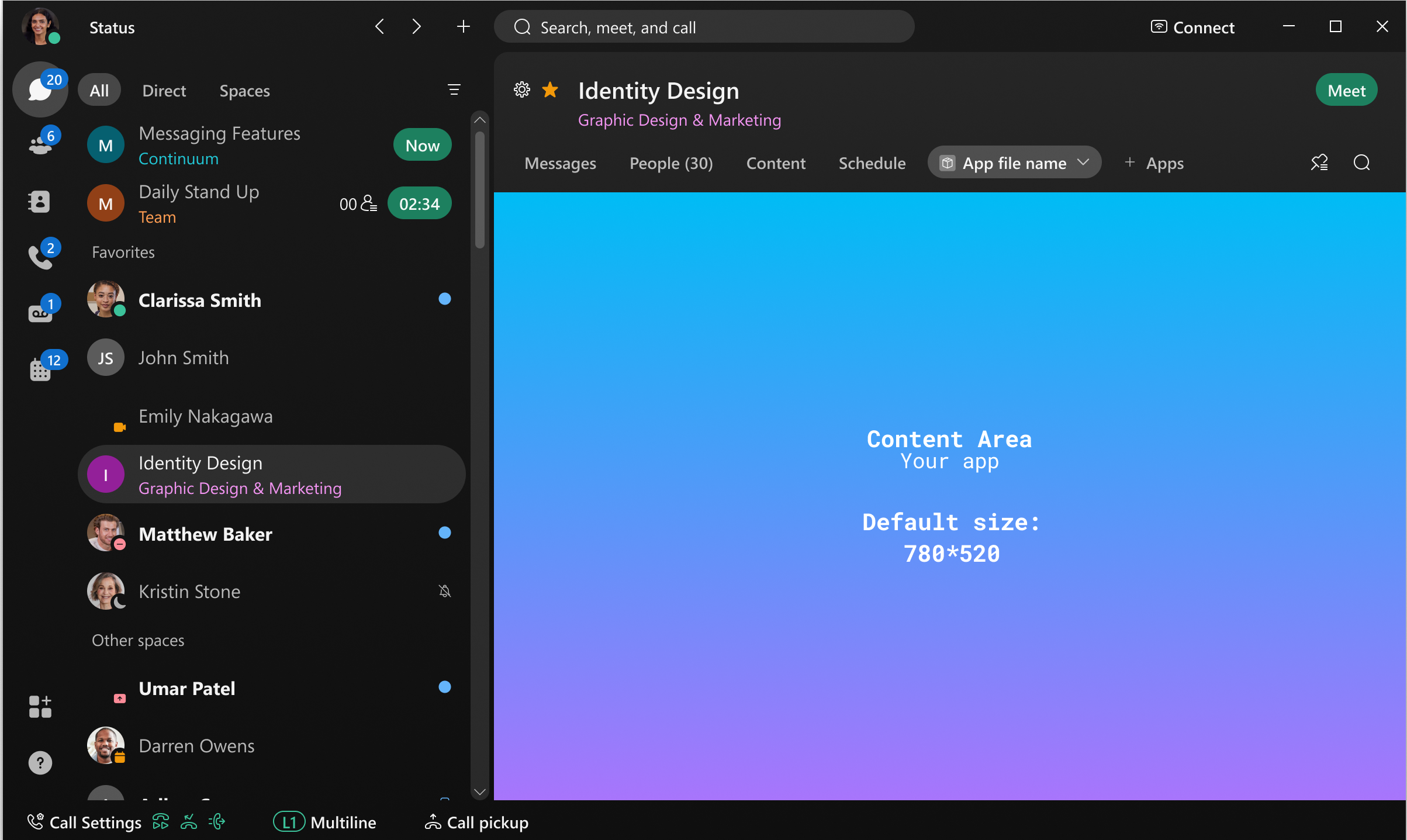
The user can pop out the space tab into an external window with a default size of 788x488px. App layout must be optimized for this initial pop-out window size.
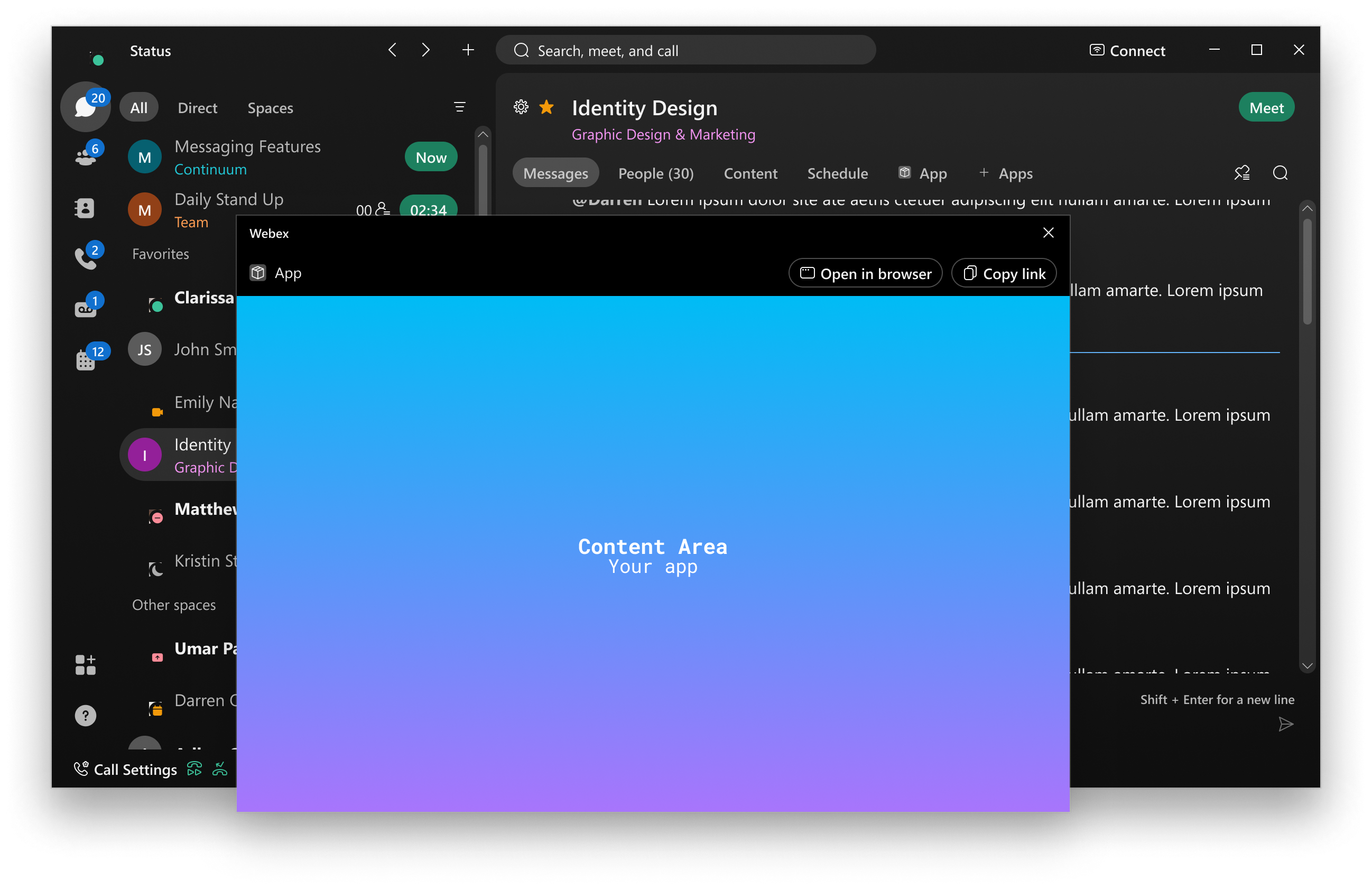
Users can resize the pop-out window to any size, so apps must be responsive to other viewports, including full screen.
Platform and Device Support
Apps must be tested and verified to function as expected on all supported desktop systems and devices, including Windows and MacOS.
Apps that are intended to be used on Webex Devices (such as the DX80 or DeskPro) must be optimized for a touch-screen experience.
Use of Pop-up Windows
In general, apps should limit their use of pop-up windows created via JavaScript. In particular:
Pop-up windows created via the
window.open()JavaScript method must not be used for primary app workflows or experiences.Use of pop-ups must be limited to entering sign-in credentials, or displaying error messages or notification messages, only. Pop-up windows must be closed once the user has completed the sign-in process or acknowledged the notification or error message.
Access to User Information
- Apps must not require a user to provide a phone number to enable use of the app. If the app solicits personal information from the user, it must not spam users with that information.
- Apps must not be dependent on access to a user's personally identifiable information (PII) to function properly. By default, access to PII in embedded apps is not enabled and apps must be able to function without access to PII. For more information, see Access to Personally Identifying Information.
- Embedded apps may obtain user information via an Integration with Webex APIs, but integrations should limit the requested scopes to the minimum their application needs to function. For more information, see Combined Webex Developer Solutions in the Embedded Apps Developer Guide.
First-time User Experience
The following are requirements for the first-time user experience.
- Apps must be easy and intuitive for first-time users and provide clear call-to-actions (CTAs) in onboarding workflows.
- If a user is required to sign-in to use the app, all available sign-in methods in the app must be functional.
- If the user needs to first sign-up (create an external account) before using the app, the app must provide guidance on how users need to complete that process.
Legibility in Light and Dark Modes
The Webex app provides users the option to enable dark or light mode for the user interface. All embedded app text and content must be visible, legible, and actionable in both color modes. In particular, apps must not have transparent backgrounds, which can make text illegible in dark mode.
Other
- If an app encounters an error condition that it cannot recover from, it must provide users with graceful exit points and appropriate messaging about the error state.
- Apps that require a user to sign-in must also provide a way for the user to sign-out.
- Apps must not display advertisements. This requirement is evaluated on a per-app basis and depends on the situation (for example, if an app's underlying business model is dependent on ads).
- Apps must not include links to extraneous pages where not actionable (for example, links to "About", "Careers", or social media sites) that would leave the user "stranded".
anchorRecommended Design Guidelines
anchorEmbedded apps are expected to follow the recommended design guidelines discussed below. While not required for approval, apps that do not incorporate these recommended guidelines may not be approved for App Hub if the reviewer determines that the app provides a poor user experience.
- Focus on Simplified Workflows and Use Cases
- Respond to User's Color Theme Preference
- Tab Names for In-Space Apps
- Sign-in Guidelines
Focus on Simplified Workflows and Use Cases
Developers should not try to repurpose or replicate their entire existing web app as an embedded app. Embedded apps benefit users with simplified use cases and workflows that add value to a Webex meeting or messaging space.
Respond to User's Color Theme Preference
Webex users can select a light or dark theme for the Webex app. To provide the best user experience, embedded apps should be responsive to the user's theme preference and provide both light and dark color themes. Minimally, an app's light theme should provide dark-colored text on a light-colored background, while the dark them should display light-colored text on a dark-colored background.
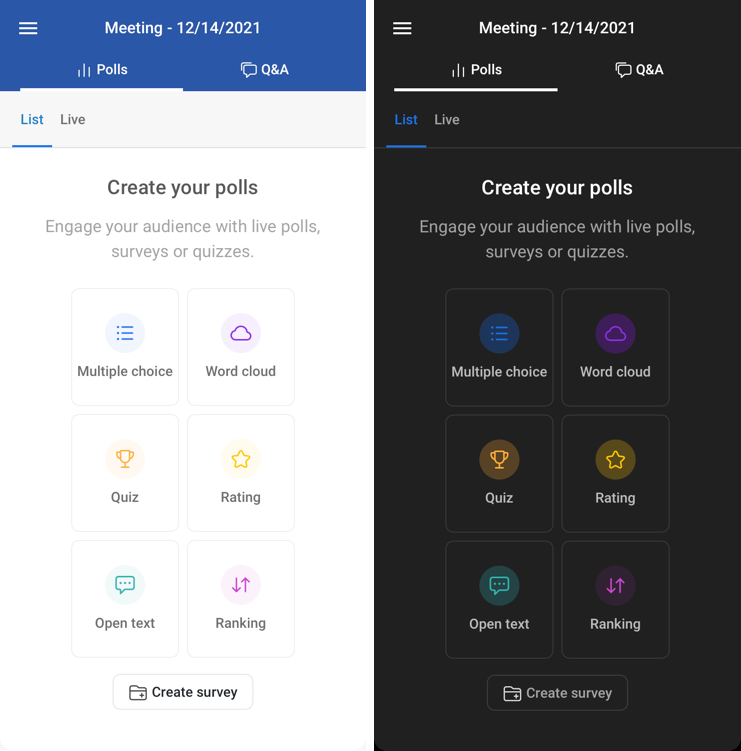
Tab Names for In-Space Apps
Each space tab is assigned a name (via the setShareURL() method) that appears on each tab. For example, the following image shows a tab named "Brainstorming."

To help users quickly identify tab names with a minimum number of visible characters, it is recommended that tab names not be prefixed with the app name. For example, the following demonstrates an example of this anti-pattern where the tab name includes the name of the app, "White Board," in this example.

Sign-in Guidelines
Apps that require user accounts should make the sign-up and sign-in processes as easy as possible for the user. Specifically, apps should incorporate the following:
- App recipients should have the same or similar sign-up and sign-in experience as the app initiator.
- Apps should use cookies and local storage to persist a user's log-in information, so that users do not need to log in each time they open a space tab. The embedded app version of your service or application should provide the same sign-in or session persistence as the browser-based version. See Using Cookies and Web Storage in the Embedded Apps developer guide for more information.
- Apps should use third-party identity providers for user sign-in only when necessary.
anchorGood-to-Have Design Guidelines
anchorThe following suggestions provide an enhanced user experience both within your app and in the larger Webex context. Incorporating these suggestions is optional and will not block app approval if not implemented.
Provide a "Freemium" Model for First-time Users
Apps that require users to create an account and select a pricing plan should provide a "freemium" model to allow first-time users an easy sign-up experience. Apps can use the participant's user ID to create a placeholder association between the user and the current app session. This ID is guaranteed to be unique regardless of whether the app has access to the user's personally identifiable information (PII).